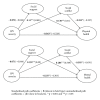Rethinking social support and conflict: lessons from a study of women who have separated from abusive partners
- PMID: 22973507
- PMCID: PMC3438734
- DOI: 10.1155/2012/738905
Rethinking social support and conflict: lessons from a study of women who have separated from abusive partners
Abstract
Relationships have both positive and negative dimensions, yet most research in the area of intimate partner violence (IPV) has focused on social support, and not on social conflict. Based on the data from 309 English-speaking Canadian women who experienced IPV in the past 3 years and were no longer living with the abuser, we tested four hypotheses examining the relationships among severity of past IPV and women's social support, social conflict, and health. We found that the severity of past IPV exerted direct negative effects on women's health. Similarly, both social support and social conflict directly influenced women's health. Social conflict, but not social support, mediated the relationships between IPV severity and health. Finally, social conflict moderated the relationships between social support and women's health, such that the positive effects of social support were attenuated in the presence of high levels of social conflict. These findings highlight that routine assessments of social support and social conflict and the use of strategies to help women enhance support and reduce conflict in their relationships are essential aspects of nursing care.
Figures
Similar articles
-
Modelling the effects of intimate partner violence and access to resources on women's health in the early years after leaving an abusive partner.Soc Sci Med. 2009 Mar;68(6):1021-9. doi: 10.1016/j.socscimed.2009.01.003. Epub 2009 Jan 31. Soc Sci Med. 2009. PMID: 19188012
-
Women's responses to intimate partner violence in Rwanda: Rethinking agency in constrained social contexts.Glob Public Health. 2016;11(1-2):65-81. doi: 10.1080/17441692.2015.1013050. Epub 2015 Mar 3. Glob Public Health. 2016. PMID: 25734771
-
Women's perceptions of their community's social norms towards assisting women who have experienced intimate partner violence.J Urban Health. 2011 Apr;88(2):240-53. doi: 10.1007/s11524-011-9546-9. J Urban Health. 2011. PMID: 21336504 Free PMC article.
-
Intimate Partner Violence and Women's Mental Health: The Mediating Role of Coping Strategies Among Women Seeking Help From the Police.J Interpers Violence. 2021 Jan;36(1-2):527-551. doi: 10.1177/0886260517729402. Epub 2017 Sep 1. J Interpers Violence. 2021. PMID: 29294903
-
The mediation effect of contraceptive use and women's autonomy on the relationship between intimate partner violence and unintended pregnancy in Ethiopia.BMC Public Health. 2020 Sep 16;20(1):1408. doi: 10.1186/s12889-020-09514-7. BMC Public Health. 2020. PMID: 32938435 Free PMC article.
Cited by
-
Intimate Partner Violence and Depression Among Latin American Women in Toronto.J Immigr Minor Health. 2015 Dec;17(6):1771-80. doi: 10.1007/s10903-014-0145-1. J Immigr Minor Health. 2015. PMID: 25472614
-
Narrative Inquiry Into Shelter-Seeking by Women With a History of Repeated Incarceration: Research and Nursing Practice Implications.ANS Adv Nurs Sci. 2018 Jul/Sep;41(3):260-274. doi: 10.1097/ANS.0000000000000216. ANS Adv Nurs Sci. 2018. PMID: 29901467 Free PMC article.
-
The impact of social support on the risk of eating disorders in women exposed to intimate partner violence.Int J Womens Health. 2015 Nov 25;7:919-31. doi: 10.2147/IJWH.S85359. eCollection 2015. Int J Womens Health. 2015. PMID: 26648759 Free PMC article.
-
Reclaiming Our Spirits: Development and Pilot Testing of a Health Promotion Intervention for Indigenous Women Who Have Experienced Intimate Partner Violence.Res Nurs Health. 2017 Jun;40(3):237-254. doi: 10.1002/nur.21795. Epub 2017 Apr 21. Res Nurs Health. 2017. PMID: 28431458 Free PMC article.
-
Patterns and Predictors of Service Use Among Women Who Have Separated from an Abusive Partner.J Fam Violence. 2015;30(4):419-431. doi: 10.1007/s10896-015-9688-8. J Fam Violence. 2015. PMID: 25960602 Free PMC article.
References
-
- World Health Organization. Multi-country Study on Women's Health and Domestic Violence: Report of Initial Results on Prevalence, Health Outcomes and Women's Responses. Geneva, Switzerland: WHO; 2005.
-
- Tjaden P, Thoennes N. Extent, Nature and Consequences of Intimate Partner Violence: Findings from the National Violence Against Women Survey. National Institute of Justice and the Center for Disease Control and Prevention, 2000.
-
- Golding JM. Intimate partner violence as a risk factor for mental disorders: a meta-analysis. Journal of Family Violence. 1999;14(2):99–132.
-
- Campbell JC. Health consequences of intimate partner violence. The Lancet. 2002;359(9314):1331–1336. - PubMed
-
- Ellsberg M, Jansen HA, Heise L, Watts CH, Garcia-Moreno C. Intimate partner violence and women’s physical and mental health in the WHO multi-country study on women’s health and domestic violence: an observational study. The Lancet. 2008;371(9619):1165–1172. - PubMed
LinkOut - more resources
Full Text Sources
Miscellaneous




